
2024 brought significant challenges to the commodities market, influenced by a dynamic macroeconomic scenario and significant climate events. Persistent in
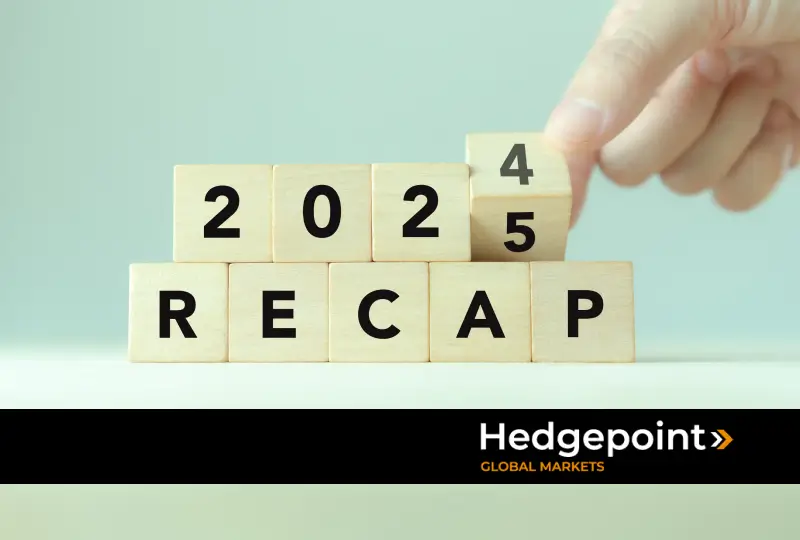
2024 brought significant challenges to the commodities market, influenced by a dynamic macroeconomic scenario and significant climate events. Persistent inflation in the United States strengthened the dollar, while changes in ECB (European Central Bank) monetary policy and the fallout from the U.S. election added volatility to the global outlook.
In agricultural commodities, adverse weather conditions impacted sugar, coffee and cocoa, with severe droughts and high costs depressing production in key regions. On the other hand, cereals faced a more favorable scenario with a recovery in Argentina and high productivity in the USA, although dry weather in Brazil posed new challenges.
The energy sector also experienced ups and downs: geopolitical tensions boosted oil prices, but weakening global demand signaled a bearish outlook for next year.
This macro review reflects the key factors that shaped prices and supply in the commodities market, highlighting the complexity and interdependence of these markets in a year full of challenges and uncertainties.
In this article, Hedgepoint provides a comprehensive analysis of the key developments in the commodities sector. Read the text and see all the highlights highlighted by our experts.
Macroeconomics in 2024
After a start to the year marked by persistent inflation in the U.S., inflationary pressures began to ease, allowing the Federal Reserve (Fed) to begin lowering interest rates in September with a 50 basis point cut. Prior to this, the European Central Bank (ECB) had already begun its monetary easing in April, resulting in a depreciation of the euro against the dollar.
Even with the Fed’s interest rate cuts from September, the dollar remained strong, supported by the uncertainties surrounding the U.S. elections. In November, the confirmation of Trump’s victory reinforced these expectations and kept the dollar at high levels.
Donald Trump’s victory led to speculation of an inflationary economic agenda, with possible tax cuts and protectionist trade policies. Meanwhile, the ECB loosened its monetary policy, improving the economic outlook for the region but weakening the euro against the dollar, which remains strong due to the longer-term maintenance of higher interest rates.
This macroeconomic context has highlighted the complexity of balancing economic stimulus and exchange rate stability in a global environment of uncertainty. See data collected throughout the year on the US Dollar Index (DXY) and the JP Morgan Emerging Markets Currency Index (USD):
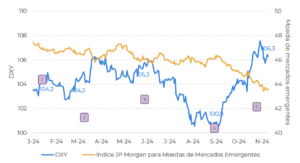
Sources: Refinitiv, Hedgepoint
Read also:
Weather and the Sugar Market in 2024: Challenges and Forecasts
The weather was the main protagonist in the sugar market in 2024. The drought and fires in the Center-South (CS) of Brazil supported prices, while the recovery of crops in the Northern Hemisphere (NH) limited the increase. Brazilian production is expected to decline in 24/25 after a record 23/24.
The good start to the 24/25 crushing season in the CS, favored by low rainfall, eased supply and put downward pressure on prices. However, the persistence of the drought and the trade flows expected in late 2024 and early 2025 supported prices. However, the persistence of the drought and the trade deficit expected for late 2024 and early 2025 supported prices. The difference between the expected availability of raw sugar and white sugar put pressure on the white sugar premium.
The rains in the CS have started to benefit the 25/26 crop, while regions such as Europe, Thailand and Central America indicate higher future supply. In addition, weak demand has put pressure on sugar prices, which find some support from supply constraints in the Brazilian off-season.
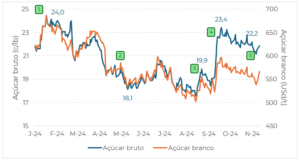
Sources: Refinitiv, Hedgepoint
See also:
Coffee in 2024: a year of highs and volatility
Adverse weather conditions made the year challenging for the coffee market, with supply constraints and below-average stocks in several producing and consuming countries. Production declines in Brazil and Vietnam were the main drivers of tight supply and price volatility.
In Vietnam, reduced production in 23/24 resulted in lower stocks, with farmers reluctant to sell even at higher prices. Hot and dry weather conditions in early 2024 increased risks for the 24/25 crop, putting pressure on Robusta prices and consequently on Arabica. In Asia, Robusta shortages in Vietnam hampered trade.
Coffee prices rose again in November, driven by storms in Central America and concerns about a small 25/26 Arabica crop in Brazil. This scenario pushed Arabica futures to new records, while Robusta prices also rose significantly.

Sources: Refinitiv, Hedgepoint
Grain Market: Money, Climate and Geopolitical Uncertainties
The year was marked by macroeconomic and climatic factors that shaped the grain market. Funds remained short throughout the year, reflecting bearish sentiment driven by robust harvests in the US and Argentina and favorable weather conditions in Brazil.
The war in the Black Sea also affected the sector, with Russian attacks damaging strategic ports and disrupting grain trade in the region. In Argentina, soybean yields returned to normal levels after the drought of 2023, while problems such as the Chicharrita pest reduced corn estimates.
In China, strategic buying on the spot market pressured prices as the country sought to diversify its sources ahead of Donald Trump’s inauguration. Trump’s re-election brought uncertainty about the trade war, with the strengthening of the dollar and the increase in Chinese inventories reducing U.S. exports and depressing prices on CBOT.
Despite good harvests in the Southern Hemisphere, dry weather in Brazil delayed soybean planting and threatened corn in the U.S. Late year rains helped improve planting conditions in Brazil and Argentina and supported U.S. logistics, but the political and geopolitical environment still added volatility to prices.

Sources: Refinitiv, Hedgepoint
Vegetable Oils in 2024: China, Margins and a Strong Dollar
The vegetable oil market was impacted by global economic and political dynamics, particularly in China, reduced crush margins and a strengthening dollar. Rumors of a delay in the EUDR also affected the market throughout the year.
A strong US dollar played a key role in the final months of the year, making soybean oil more competitive against palm oil. However, low production numbers and high local prices in China boosted palm oil futures. Fund activity, particularly in soybean oil, supported prices, while mid-year profit taking pressured palm oil values.
As crush margins recovered in China, economic activity picked up, supporting the market. Supply constraints in Thailand and increased imports from India contributed to a recovery in palm oil. Policy decisions by the Trump administration, particularly on tariffs, are eagerly awaited and could further alter the balance of vegetable oils.
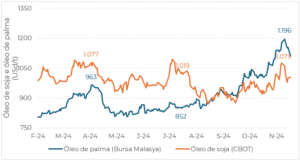
Sources: Refinitiv, Hedgepoint
Cocoa Production: Challenges and Recovery Prospects
Global cocoa production faced significant challenges in 23/24, with Ivory Coast and Ghana recording below-average volumes due to extreme weather conditions, high production costs and economic crises. Although a recovery is expected in 24/25, volumes are still expected to be below expectations, particularly in Ghana.
In early 2024, prices began to respond to tighter global supplies, but the market still expected demand to decline due to higher prices. Both the Cocoa Association of Asia and the Cocoa Association of Europe reported a decline in crushing at the end of last year. However, with weather challenges in key producing regions, cocoa set successive records in the first and early second half of the year.
Despite optimistic forecasts, such as an increase in Ivory Coast production to 2 million tonnes in 24/25, the global equity index fell to its lowest level in 50 years as the market remained wary of the climatic and phytosanitary impact on the upcoming crop.
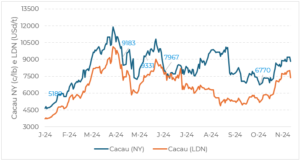
Sources: Refinitiv, Hedgepoint
Geopolitics and oil: the highlights of 2024
The geopolitical scenario defined the direction of the energy market in 2024. Conflicts such as that between Israel and Hamas and the war between Ukraine and Russia boosted oil prices, while weakening global demand, particularly in China, led to a bearish outlook for 2025.
The year began with prices supported by low temperatures in the US, which disrupted production and refinery operations. In April, attacks related to the conflict between Israel and Hamas, including direct tensions with Iran, increased risk premiums.
From August onwards, signs of weakening demand, in particular a fall in China’s oil imports, added to market concerns. Donald Trump’s victory in the US elections in November is expected to boost fossil fuel production and increase domestic production.
Nevertheless, rising global supply combined with weaker Asian demand led to a more bearish tone for energy commodities towards the end of the year, setting the market up for a transition in 2025.
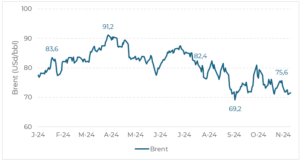
Sources: Refinitiv, Hedgepoint
See also:
Follow other reports on the Hedgepoint HUB
Access other complete commodity market reports directly on the Hedgepoint HUB. Experts discuss data on supply, demand, weather forecasts, acreage and more. Check it out now!

Rua Funchal, 418, 18º andar - Vila Olímpia São Paulo, SP, Brasil
Contato
(00) 99999-8888 example@mail.com
Section
Home
O que Fazemos
Mercado
Quem Somos
HUB
Blog
Esta página foi preparada pela Hedgepoint Schweiz AG e suas afiliadas (“Hedgepoint”) exclusivamente para fins informativos e instrutivos, sem o objetivo de estabelecer obrigações ou compromissos com terceiros, nem de promover uma oferta ou solicitação de oferta de venda ou compra de quaisquer valores mobiliários, commodity interests ou produtos de investimento.
A Hedgepoint e suas associadas renunciam expressamente a qualquer uso das informações contidas neste documento que direta ou indiretamente resulte em danos ou prejuízos de qualquer natureza. As informações são obtidas de fontes que acreditamos serem confiáveis, mas não garantimos a atualidade ou precisão dessas informações.
O trading de commodity interests, como futuros, opções e swaps, envolve um risco substancial de perda e pode não ser adequado para todos os investidores. Você deve considerar cuidadosamente se esse tipo de negociação é adequado para você, levando em conta sua situação financeira. O desempenho passado não é necessariamente indicativo de resultados futuros. Os clientes devem confiar em seu próprio julgamento independente e/ou consultores antes de realizar qualquer transação.
A Hedgepoint não fornece consultoria jurídica, tributária ou contábil, sendo de sua responsabilidade buscar essas orientações separadamente.
A Hedgepoint Schweiz AG está organizada, constituída e existente sob as leis da Suíça, é afiliada à ARIF, a Associação Romande des Intermédiaires Financiers, que é uma Organização de Autorregulação autorizada pela FINMA. A Hedgepoint Commodities LLC está organizada, constituída e existente sob as leis dos Estados Unidos, sendo autorizada e regulada pela Commodity Futures Trading Commission (CFTC) e é membro da National Futures Association (NFA), atuando como Introducing Broker e Commodity Trading Advisor. A Hedgepoint Global Markets Limited é regulada pela Dubai Financial Services Authority. O conteúdo é direcionado a Clientes Profissionais e não a Clientes de Varejo. A Hedgepoint Global Markets PTE. Ltd está organizada, constituída e existente sob as leis de Singapura, isenta de obter uma licença de serviços financeiros conforme o Segundo Anexo do Securities and Futures (Licensing and Conduct of Business) Act, pela Monetary Authority of Singapore (MAS). A Hedgepoint Global Markets DTVM Ltda. é autorizada e regulada no Brasil pelo Banco Central do Brasil (BCB) e pela Comissão de Valores Mobiliários (CVM). A Hedgepoint Serviços Ltda. está organizada, constituída e existente sob as leis do Brasil. A Hedgepoint Global Markets S.A. está organizada, constituída e existente sob as leis do Uruguai.
Em caso de dúvidas não resolvidas no primeiro contato com o atendimento ao cliente (client.services@hedgepointglobal.com), entre em contato com o canal de ouvidoria interna (ombudsman@hedgepointglobal.com – global ou ouvidoria@hedgepointglobal.com – apenas Brasil) ou ligue para 0800-8788408 (apenas Brasil).
Integridade, ética e transparência são valores que guiam nossa cultura. Para fortalecer ainda mais nossas práticas, a Hedgepoint possui um canal de denúncias para colaboradores e terceiros via e-mail ethicline@hedgepointglobal.com ou pelo formulário Ethic Line – Hedgepoint Global Markets.
Nota de segurança: Todos os contatos com clientes e parceiros são realizados exclusivamente por meio do nosso domínio @hedgepointglobal.com. Não aceite informações, boletos, extratos ou solicitações de outros domínios e preste atenção especial a variações em letras ou grafias, pois podem indicar uma situação fraudulenta.
“Hedgepoint” e o logotipo “Hedgepoint” são marcas de uso exclusivo da Hedgepoint e/ou de suas afiliadas. O uso ou reprodução é proibido, a menos que expressamente autorizado pela HedgePoint.
Além disso, o uso de outras marcas neste documento foi autorizado apenas para fins de identificação. Isso, portanto, não implica quaisquer direitos da HedgePoint sobre essas marcas ou implica endosso, associação ou aprovação pelos proprietários dessas marcas com a Hedgepoint ou suas afiliadas.
aA Hedgepoint Global Markets é correspondente cambial do Ebury Banco de Câmbio, de acordo com a resolução CMN Nº 4.935, DE 29 DE JULHO DE 2021, Artigo 14 do Banco Central do Brasil (BACEN).
Para mais informações sobre nosso parceiro, serviços disponíveis, atendimento e ouvidoria, acesse o link a seguir: https://br.ebury.com/